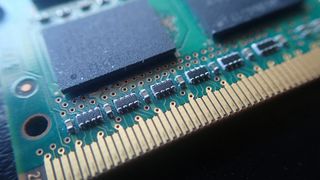Samsung unveils industry first 512GB DDR5 RAM
New memory module is meant for data center use, so won’t come cheap

Samsung has claimed it has developed the industry's first 512 GB module of DDR5 memory, running at DDR5-7200.
Designed for server and enterprise use, Samsung shared details about the new RAM module at the recent Hot Chips semiconductor conference.
Reporting on Samsung’s presentation, Tom’s Hardware notes that the new DDR5-7400 memory module is based on the standard DDR5 specifications and runs at 1.1 volts, yet offers a 40% higher performance with twice the capacity, as compared to DDR4.
- Here’s our recommendation of the best RAM for your PC
- We've built a list of the best workstations on the market
- These are the best system utilities and repair software for your business PC
In the presentation, Samsung shared technical details about the new features and functionalities it has baked into the new module in order to increase its energy efficiency and support higher transfer rates.
Smaller and efficient
In its presentation, Samsung credited the increased efficiency of the new memory module to the use of Same-Bank refresh (SBR) technology, which helps make the modules at least 10% more power efficient when compared to DDR4-4200 type-RAM.
One interesting innovation in the new memory module helps Samsung increase the capacity without increasing its physical size. The company claims to stack eight DDR5 dies, which still ends up being smaller than four stacked DDR dies, thanks to thin wafer handling techniques that help it reduce the gap between dies by up to 40% and achieve a slimmer profile.
However, DDR5 is still some ways off from mainstream adoption, with Samsung not expecting mass market adoption until 2023 or 2024. Furthermore, Tom’s Hardware notes that while the 512GB DDR5 memory module is exciting, it is meant for the data center and server market, with consumer DDR5 memory likely topping out at 64GB.
Are you a pro? Subscribe to our newsletter
Sign up to the TechRadar Pro newsletter to get all the top news, opinion, features and guidance your business needs to succeed!
- Take a look at these best laptops for business
Via Tom’s Hardware
With almost two decades of writing and reporting on Linux, Mayank Sharma would like everyone to think he’s TechRadar Pro’s expert on the topic. Of course, he’s just as interested in other computing topics, particularly cybersecurity, cloud, containers, and coding.

